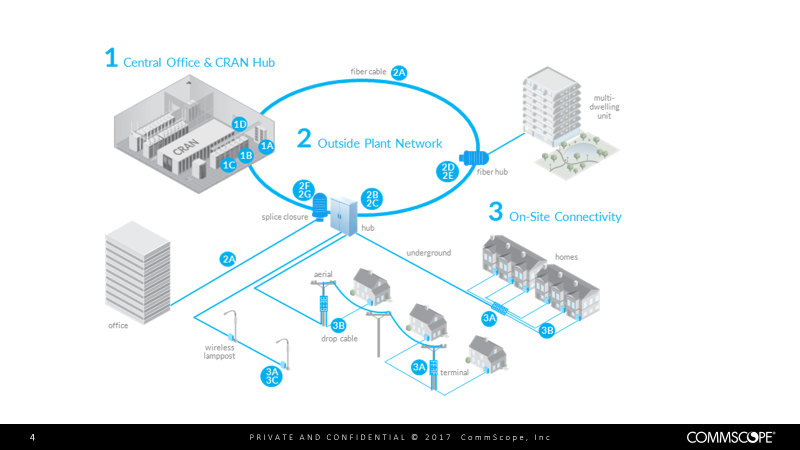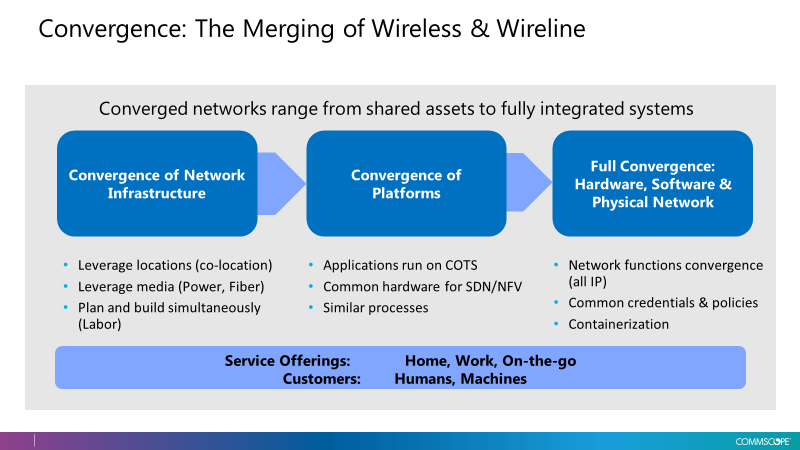Network convergence is defined as the use of multiple communication modes on a single network that offers convenience and flexibility that are not possible with separate infrastructures. As we look ahead to 2018 and beyond, the attributes of a solid converged network are flexibility, reliability and cost savings. While widespread deployment of 5G is still a few years off, there is much to be done behind the scenes to ensure networks are ready for the change.
The ubiquitous need for bandwidth in our internet-centric world has driven landline networks, as well as more recently deployed wireless networks, to network convergence. In the future, all networks are moving toward delivering high speed digital data from a data or processing source, through a high bandwidth or “broadband” network, to a wireless distribution point and reverse for the upstream.
Now and in the Future
The next wireless network architecture evolution is 4G/LTE densification and 5G wireless. This evolution is a convergence of the physical assets of fixed networks and wireless access points. For example, in North America, LTE coverage is relatively ubiquitous. Wireless “coverage” is complete for all intents and purposes. The issue, as consumer demand for data increases, is capacity. Wireless capacity can be increased in several ways: better modulation techniques, more spectrum or spatially. 4G/LTE densification and potentially 5G mobility create more capacity spatially. More small cells closer to each other (250 meters) means that there are less users at each access point, which effectively creates more bandwidth per square meter. The promise of fixed wireless 5G in the sub 6 GHz range and millimeter wave band (i.e. 28GHz) creates more bandwidth with additional spectrum as well.
When we think of convergence, we generally are considering these three types of networks and their typical configurations:
- In the multi-service organization or legacy community access television network, there is a headend connected via router to data centers.The network consists of a high bandwidth hybrid fiber coax network.At the consumer/enterprise end of the network, the obvious trend is toward WiFi wireless connectivity in the home or in the office.
- In legacy telephony networks, central offices or mobile switching centers are connected via high speed routers to data centers and other switching centers.The legacy telephony network consists of a legacy copper network, a version of FTTN (fiber to the node) supporting some form of advanced DSL service or an fiber to the home network.As in the HFC example, home and business routers and WiFi are typically activated.
- A traditional cellular network is comprised of a network of macro cells, each independently powered and interconnected by a backhaul network of varying types, inclusive of fiber, HFC, copper and microwave.
These three different networks all look different when deployed due to the need to meet different communications applications. Now they are all beginning to resemble each other to the point the networks can and will merge into one, saving operator OpEx and CapEx as equipment requirements also become identical. This is network convergence. It not only drives the networks toward looking the same, but CapEx will be reduced as manufactures and NFV/SDN (network function virtualization/software defined networks) become standard.

Network Requirements for Convergence
In a converged network, three things are required:
- Power (for wireless access points, as well as other edge devices)
The requirement for power at every wireless access point is essential, but often assumed as available or even forgotten until the completion of network planning. Each legacy telecommunications network has different powering considerations. But make no mistake: the requirement for power in a converged network is real, and the importance cannot be overstated.
Legacy telephone networks, where twisted pair still exists and maintained, can provide low levels of power for small cells. In general, for a converged network, legacy telephony networks require utility power to be acquired unless a wireless access point is collocated at a power cabinet.
FTTH PON networks simply do not have this access to power, apart from the installation of a utility drop and meter installation. While a utility drop can be acquired at reasonable cost, and perhaps in a reasonable timeframe, the installation of a utility drop at hundreds or thousands of access point locations will quickly become both an economic burden as well as a project bottleneck.
Estimates are that 80 percent of HFC plant miles have network power availability due to the power on the coax. Coax in many cases runs parallel as a back-feed from an optical node thereby creating power availability even in fiber portions of the plant. In most cases the power availability is more than adequate for Wi-Fi hotspots or small cells.
- Backhaul (data from the edge access points to the central data storage or processing centers)
Traditionally backhaul from cell sites has been done either though high-speed twisted pair, microwave or fiber links from radio locations to centralized equipment locations. These can be dedicated links or shared via time domain or wavelength-division multiplexing.
In an existing HFC network, backhaul capacity can also be provided via DOCSIS. DOCSIS provides connectivity over either coaxial or fiber links. Equipment to condition power from the HFC plant to activate wireless access points via PoE (power over Ethernet) while providing a DOCSIS channel also exist. For small cells, depending on the technology deployed, tight timing and latency requirements are a concern, but these issues are currently being addressed in standards organizations.
“Fronthauling” wireless data employs CPRI (Common Protocol Radio Interface) signaling. This signaling technology is currently required by LTE radios if coordinated multipoint is deployed to allow for the reuse of spectrum and mitigates interference. The dedicated link is usually a pair of fibers per radio deployed, but a fiber pair can be shared for multiple fronthauls via WDM, as long as the signaling paths are independent and no longer than 15 km.
New technologies such as the packet switchable ECPI standard are also evolving. The intent of this new standard is to decrease sensitivity to new required 5G latencies, reduce required data rates, and still allow for centralized radio coordination in order to reuse spectrum.
- Site acquisition
Going forward, the majority of wireless mobility to be deployed for LTE densification or 5G will be deployed in high capacity urban and suburban areas.
Site acquisition is always a major part of any wireless network. Typically, it takes time and money to secure. The 4G/LTE wireless densification effort is about capacity, not coverage, and 20-30 feet in the air is adequate for the coverage of a small cell area to create the additional capacity desired. For underground plant, small cabinet based cells are available, with varying tower heights and a variety of concealment methods. These small calls can be very unobtrusive, and placed along right of way already established for pedestals and cabinets.

Convergence of our telecommunications’ networks is a natural economic and technical evolution expedited by wireless small cell densification. Power, backhaul and site availability are of utmost importance in the design of any radio access network.
Throughout 2018 and beyond the migration toward network convergence will continue. The physical assets of networks will begin to be consolidated, and the same plant facilities will be used for wireless backhaul/fronthaul, FTTx, HFC, fixed wireless access, and commercial high speed data requirements via a highly leveraged optical fiber facility. NFV will continue to evolve as well, making all central processing facilities, whether datacenter, headend, central office, or mobile switching center all resemble each other running applications on COTS and eventually physically merge.
In addition, the signaling technology in the outside plant will migrate toward an IP, packet-switched network allowing for the convergence of different service’s signals within the same data stream.
Vendors understand and are aligned to facilitate the financial motivations for network convergence and the need for cost effective solutions. New solutions are being developed to facilitate convergence, and more will be coming in the next few years.

